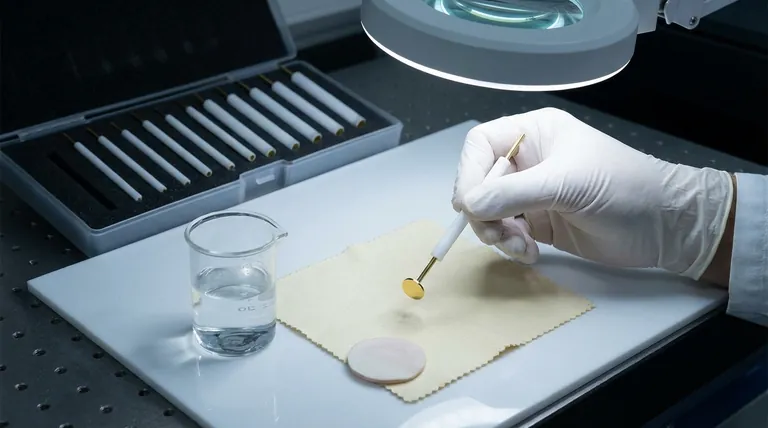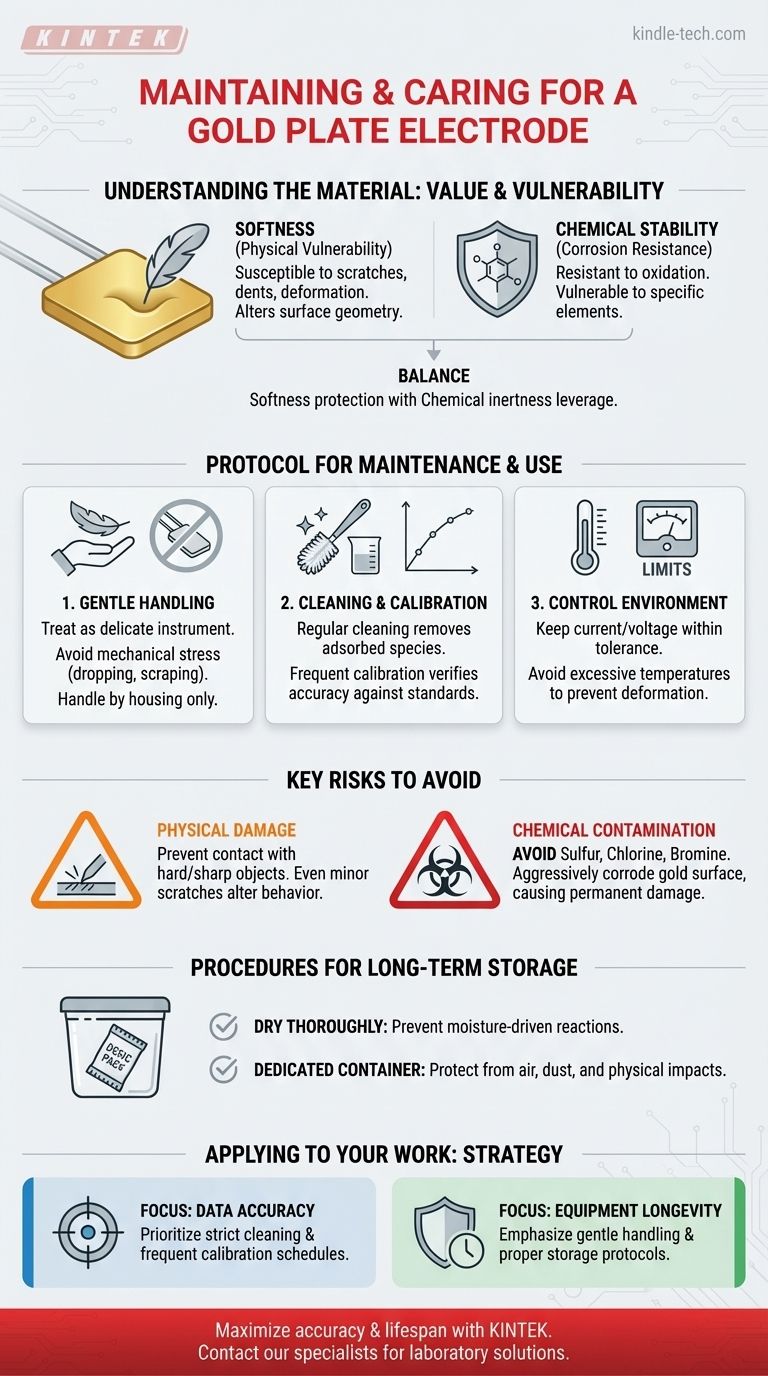Proper maintenance of a gold plate electrode is a function of its core material properties: its physical softness and its chemical stability. The key practices involve meticulous handling to prevent physical damage, routine cleaning and calibration to ensure measurement accuracy, and controlled storage to protect it from specific chemical contaminants and environmental exposure.
The central challenge with a gold electrode is balancing its two defining traits. You must protect its soft, delicate surface from any physical damage while leveraging its exceptional chemical inertness through disciplined cleaning and storage protocols.

Understanding the Material: Why Gold Requires Special Care
To maintain a gold electrode effectively, you must first understand the properties that make it both valuable and vulnerable. Its performance is directly tied to its physical and chemical nature.
The Vulnerability of Softness
Gold is an exceptionally soft metal. The thin sheets used for electrodes, often between 0.1mm and 0.5mm thick, are highly susceptible to physical damage.
This softness means the electrode surface can be easily scratched, dented, or deformed by impacts, squeezing, or even contact with hard objects. Such damage alters the electrode's surface area and geometry, compromising the accuracy and reproducibility of your measurements.
Exceptional Chemical Stability
Gold's primary advantage is its excellent corrosion resistance and chemical stability. It does not easily oxidize in most electrochemical environments, which ensures consistent performance over time.
However, this stability is not absolute. Certain elements can react with and corrode the gold surface, permanently altering its properties.
A Protocol for Electrode Maintenance and Use
A consistent protocol is essential for preserving the integrity of the electrode and ensuring the quality of your data.
Gentle Handling is Non-Negotiable
Always treat the electrode as a delicate instrument. Avoid any action that could cause mechanical stress, such as dropping, scraping, or applying excessive pressure.
When mounting or moving the electrode, handle it by its housing or designated non-active areas to avoid touching the gold surface.
Cleaning and Calibration
For precise and repeatable work, the electrode surface must be clean and its response known. Regular cleaning removes adsorbed species from the surface that could interfere with your experiment.
Follow cleaning with regular calibration. This practice verifies the electrode's performance against a known standard, ensuring your measurements remain accurate. The frequency of calibration depends on the intensity of use and the precision required by your application.
Controlling the Operating Environment
During use, keep the applied current and voltage within the electrode's specified tolerance range to prevent electrochemical damage.
Additionally, avoid using or storing the electrode at excessively high temperatures, which can cause the thin gold plate to deform.
Understanding the Key Risks
Awareness of specific threats is critical for preventing irreversible damage to your electrode. These risks are both physical and chemical.
The Threat of Physical Damage
Scratches and abrasions are the most common form of damage. Preventing contact with any hard or sharp objects is paramount. Even minor surface changes can create active sites that alter electrochemical behavior.
The Danger of Chemical Contamination
While generally inert, gold is vulnerable to certain substances. Keep the electrode away from any materials containing sulfur, chlorine, and bromine.
These elements can aggressively corrode the gold surface, leading to permanent damage and inaccurate readings. This includes avoiding exposure to their vapors in the lab environment.
Procedures for Long-Term Storage
Proper storage is just as important as proper handling. Incorrect storage can degrade an electrode even when it is not in use.
Dry and Protect from Air
After use and cleaning, the electrode must be dried thoroughly. Moisture can trap contaminants and promote unwanted chemical reactions on the surface over time.
Once dry, store it in a way that protects it from open air and dust.
Use a Dedicated Container
The best practice is to keep the electrode in a clean, dedicated, and properly labeled container. This protects it from accidental physical impacts, scratches, and exposure to airborne contaminants in the laboratory.
Applying This to Your Work
Your maintenance strategy should align with your primary experimental goals.
- If your primary focus is data accuracy: Prioritize a strict schedule of meticulous cleaning and frequent calibration to ensure your measurements are reliable and reproducible.
- If your primary focus is equipment longevity: Emphasize gentle handling and proper storage protocols above all else to prevent irreversible physical or chemical damage.
By respecting the unique properties of gold, you ensure your electrode remains a reliable and precise instrument for your work.
Summary Table:
| Maintenance Aspect | Key Action | Primary Goal |
|---|---|---|
| Handling | Avoid physical contact, impacts, and pressure. | Prevent scratches, dents, and deformation. |
| Cleaning & Calibration | Regular cleaning and performance verification. | Ensure measurement accuracy and reproducibility. |
| Chemical Risks | Avoid sulfur, chlorine, and bromine. | Prevent irreversible chemical corrosion. |
| Storage | Dry thoroughly and store in a dedicated container. | Protect from moisture, dust, and physical damage. |
Maximize the accuracy and lifespan of your sensitive lab equipment with KINTEK. Our expertise in laboratory equipment and consumables ensures you have the right tools and knowledge for precise electrochemical work. Contact our specialists today to discuss your specific electrode and laboratory needs.
Visual Guide

Related Products
- Gold Disc Electrode
- Gold Electrochemical Sheet Electrode Gold Electrode
- Platinum Sheet Electrode for Laboratory and Industrial Applications
- Platinum Auxiliary Electrode for Laboratory Use
- Copper Sulfate Reference Electrode for Laboratory Use
People Also Ask
- What are the performance characteristics of a gold plate electrode? Unmatched Stability for Reliable Data
- What are the necessary pretreatment steps before using a gold disc electrode? A Guide to Reliable Electrochemical Data
- What is the proper post-treatment and storage procedure for a gold disc electrode? Ensure Reliable Electrochemical Data
- What are gold electrodes used for? Achieve Unmatched Sensitivity in Biosensing and Research
- What is the typical role of a gold disc electrode in an electrochemical setup? Your Guide to a Precise Working Electrode



















